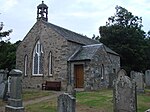Dalguise
Beatrix PotterPerth and Kinross geography stubsUse British English from December 2017Villages in Perth and Kinross

Dalguise (Scottish Gaelic Dàil Ghiuthais) is a settlement in Perth and Kinross, Scotland. It is situated on the western side of the River Tay on the B898 road, 5 miles (8 kilometres) north of Dunkeld. Located there is Dalguise House, a place where, from the age of four, Beatrix Potter stayed annually with her family throughout the summer, from May till the end of the salmon season.
Excerpt from the Wikipedia article Dalguise (License: CC BY-SA 3.0, Authors, Images).Dalguise
B898,
Geographical coordinates (GPS) Address Nearby Places Show on map
Geographical coordinates (GPS)
| Latitude | Longitude |
|---|---|
| N 56.609379 ° | E -3.645429 ° |
Address
Dalguise Activity Centre
B898
PH8 0JU
Scotland, United Kingdom
Open on Google Maps








